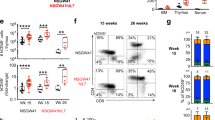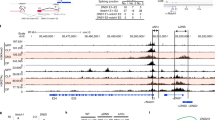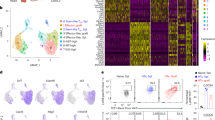Abstract
Although the development of regulatory T cells (Treg cells) in the thymus is defined by expression of the lineage marker Foxp3, the precise function of Foxp3 in Treg cell lineage commitment is unknown. Here we examined Treg cell development and function in mice with a Foxp3 allele that directs expression of a nonfunctional fusion protein of Foxp3 and enhanced green fluorescent protein (Foxp3ΔEGFP). Thymocyte development in Foxp3ΔEGFP male mice and Foxp3ΔEGFP/+ female mice recapitulated that of wild-type mice. Although mature EGFP+ CD4+ T cells from Foxp3ΔEGFP mice lacked suppressor function, they maintained the characteristic Treg cell 'genetic signature' and failed to develop from EGFP− CD4+ T cells when transferred into lymphopenic hosts, indicative of their common ontogeny with Treg cells. Our results indicate that Treg cell effector function but not lineage commitment requires the expression of functional Foxp3 protein.
NOTE: In the version of this article initially published online, the ‘Foxp2EGFP’ and ‘Foxp2ΔEGFP’ labels in Figure 7 are incorrect. The correct labels should be ‘Foxp3EGFP’ and ‘Foxp3ΔEGFP’, respectively. Also, Supplementary Tables 1-3 truncated early. The errors have been corrected for all versions of the article.
This is a preview of subscription content, access via your institution
Access options
Subscribe to this journal
Receive 12 print issues and online access
$209.00 per year
only $17.42 per issue
Buy this article
- Purchase on Springer Link
- Instant access to full article PDF
Prices may be subject to local taxes which are calculated during checkout







Similar content being viewed by others
Accession codes
Change history
18 February 2007
NOTE: In the version of this article initially published online, the ‘Foxp2EGFP’ and ‘Foxp2ΔEGFP’ labels in Figure 7 are incorrect. The correct labels should be ‘Foxp3EGFP’ and ‘Foxp3ΔEGFP’, respectively. Also, Supplementary Tables 1-3 truncated early. The errors have been corrected for all versions of the article.
References
Sakaguchi, S. Naturally arising CD4+ regulatory T cells for immunologic self-tolerance and negative control of immune responses. Annu. Rev. Immunol. 22, 531–562 (2004).
Fontenot, J.D. & Rudensky, A.Y. A well adapted regulatory contrivance: regulatory T cell development and the forkhead family transcription factor Foxp3. Nat. Immunol. 6, 331–337 (2005).
Apostolou, I., Sarukhan, A., Klein, L. & von Boehmer, H. Origin of regulatory T cells with known specificity for antigen. Nat. Immunol. 3, 756–763 (2002).
Jordan, M.S. et al. Thymic selection of CD4+CD25+ regulatory T cells induced by an agonist self-peptide. Nat. Immunol. 2, 301–306 (2001).
Bensinger, S.J., Bandeira, A., Jordan, M.S., Caton, A.J. & Laufer, T.M. Major histocompatibility complex class II-positive cortical epithelium mediates the selection of CD4+25+ immunoregulatory T cells. J. Exp. Med. 194, 427–438 (2001).
Cabarrocas, J. et al. Foxp3+ CD25+ regulatory T cells specific for a neo-self-antigen develop at the double-positive thymic stage. Proc. Natl. Acad. Sci. USA 103, 8453–8458 (2006).
Hsieh, C.S., Zheng, Y., Liang, Y., Fontenot, J.D. & Rudensky, A.Y. An intersection between the self-reactive regulatory and nonregulatory T cell receptor repertoires. Nat. Immunol. 7, 401–410 (2006).
Pacholczyk, R., Ignatowicz, H., Kraj, P. & Ignatowicz, L. Origin and T cell receptor diversity of Foxp3+CD4+CD25+ T cells. Immunity 25, 249–259 (2006).
Lyon, M.F., Peters, J., Glenister, P.H., Ball, S. & Wright, E. The scurfy mouse mutant has previously unrecognized hematological abnormalities and resembles Wiskott-Aldrich syndrome. Proc. Natl. Acad. Sci. USA 87, 2433–2437 (1990).
Godfrey, V.L., Wilkinson, J.E. & Russell, L.B. X-linked lymphoreticular disease in the scurfy (sf) mutant mouse. Am. J. Pathol. 138, 1379–1387 (1991).
Fontenot, J.D., Gavin, M.A. & Rudensky, A.Y. Foxp3 programs the development and function of CD4+CD25+ regulatory T cells. Nat. Immunol. 4, 330–336 (2003).
Lin, W. et al. Allergic dysregulation and hyperimmunoglobulinemia E in Foxp3 mutant mice. J. Allergy Clin. Immunol. 116, 1106–1115 (2005).
Chatila, T.A. et al. JM2, encoding a fork head-related protein, is mutated in X-linked autoimmunity-allergic disregulation syndrome. J. Clin. Invest. 106, R75–R81 (2000).
Wildin, R.S. et al. X-linked neonatal diabetes mellitus, enteropathy and endocrinopathy syndrome is the human equivalent of mouse scurfy. Nat. Genet. 27, 18–20 (2001).
Bennett, C.L. et al. The immune dysregulation, polyendocrinopathy, enteropathy, X-linked syndrome (IPEX) is caused by mutations of FOXP3. Nat. Genet. 27, 20–21 (2001).
Kawahata, K. et al. Generation of CD4+CD25+ regulatory T cells from autoreactive T cells simultaneously with their negative selection in the thymus and from nonautoreactive T cells by endogenous TCR expression. J. Immunol. 168, 4399–4405 (2002).
Hori, S., Nomura, T. & Sakaguchi, S. Control of regulatory T cell development by the transcription factor Foxp3. Science 299, 1057–1061 (2003).
van Santen, H.M., Benoist, C. & Mathis, D. Number of T reg cells that differentiate does not increase upon encounter of agonist ligand on thymic epithelial cells. J. Exp. Med. 200, 1221–1230 (2004).
Gavin, M.A. et al. Single-cell analysis of normal and FOXP3-mutant human T cells: FOXP3 expression without regulatory T cell development. Proc. Natl. Acad. Sci. USA 103, 6659–6664 (2006).
Taguchi, O. & Takahashi, T. Administration of anti-interleukin-2 receptor α antibody in vivo induces localized autoimmune disease. Eur. J. Immunol. 26, 1608–1612 (1996).
McHugh, R.S. & Shevach, E.M. Cutting edge: depletion of CD4+CD25+ regulatory T cells is necessary, but not sufficient, for induction of organ-specific autoimmune disease. J. Immunol. 168, 5979–5983 (2002).
Wu, Y. et al. FOXP3 controls regulatory T cell function through cooperation with NFAT. Cell 126, 375–387 (2006).
Stroud, J.C. et al. Structure of the forkhead domain of FOXP2 bound to DNA. Structure 14, 159–166 (2006).
Lopes, J.E. et al. Analysis of FOXP3 reveals multiple domains required for its function as a transcriptional repressor. J. Immunol. 177, 3133–3142 (2006).
Haribhai, D. et al. Regulatory T cells dynamically control the primary immune response to foreign antigen. J. Immunol. (in the press).
Bendelac, A., Matzinger, P., Seder, R.A., Paul, W.E. & Schwartz, R.H. Activation events during thymic selection. J. Exp. Med. 175, 731–742 (1992).
Feng, C. et al. A potential role for CD69 in thymocyte emigration. Int. Immunol. 14, 535–544 (2002).
Liu, W. et al. CD127 expression inversely correlates with FoxP3 and suppressive function of human CD4+ T reg cells. J. Exp. Med. 203, 1701–1711 (2006).
Seddiki, N. et al. Expression of interleukin (IL)-2 and IL-7 receptors discriminates between human regulatory and activated T cells. J. Exp. Med. 203, 1693–1700 (2006).
Huehn, J. et al. Developmental stage, phenotype, and migration distinguish naive- and effector/memory-like CD4+ regulatory T cells. J. Exp. Med. 199, 303–313 (2004).
Izcue, A., Coombes, J.L. & Powrie, F. Regulatory T cells suppress systemic and mucosal immune activation to control intestinal inflammation. Immunol. Rev. 212, 256–271 (2006).
Fontenot, J.D. et al. Regulatory T cell lineage specification by the forkhead transcription factor Foxp3. Immunity 22, 329–341 (2005).
Gavin, M.A., Clarke, S.R., Negrou, E., Gallegos, A. & Rudensky, A. Homeostasis and anergy of CD4+CD25+ suppressor T cells in vivo. Nat. Immunol. 3, 33–41 (2002).
Chen, Z., Herman, A.E., Matos, M., Mathis, D. & Benoist, C. Where CD4+CD25+ T reg cells impinge on autoimmune diabetes. J. Exp. Med. 202, 1387–1397 (2005).
Sugimoto, N. et al. Foxp3-dependent and -independent molecules specific for CD25+CD4+ natural regulatory T cells revealed by DNA microarray analysis. Int. Immunol. 18, 1197–1209 (2006).
Sun, H., Lu, B., Li, R.Q., Flavell, R.A. & Taneja, R. Defective T cell activation and autoimmune disorder in Stra13-deficient mice. Nat. Immunol. 2, 1040–1047 (2001).
He, Y.W. Orphan nuclear receptors in T lymphocyte development. J. Leukoc. Biol. 72, 440–446 (2002).
Glimcher, L.H., Townsend, M.J., Sullivan, B.M. & Lord, G.M. Recent developments in the transcriptional regulation of cytolytic effector cells. Nat. Rev. Immunol. 4, 900–911 (2004).
Kim, C.H. et al. Bonzo/CXCR6 expression defines type 1-polarized T-cell subsets with extralymphoid tissue homing potential. J. Clin. Invest. 107, 595–601 (2001).
Khattri, R., Cox, T., Yasayko, S.A. & Ramsdell, F. An essential role for Scurfin in CD4+CD25+ T regulatory cells. Nat. Immunol. 4, 337–342 (2003).
Schubert, L.A., Jeffery, E., Zhang, Y., Ramsdell, F. & Ziegler, S.F. Scurfin (FOXP3) acts as a repressor of transcription and regulates T cell activation. J. Biol. Chem. 276, 37672–37679 (2001).
Bettelli, E., Dastrange, M. & Oukka, M. Foxp3 interacts with nuclear factor of activated T cells and NF-kappa B to repress cytokine gene expression and effector functions of T helper cells. Proc. Natl. Acad. Sci. USA 102, 5138–5143 (2005).
Kim, J.M., Rasmussen, J.P. & Rudensky, A.Y. Regulatory T cells prevent catastrophic autoimmunity throughout the lifespan of mice. Nat. Immunol. 8, 191–197 (2007).
Almeida, A.R., Zaragoza, B. & Freitas, A.A. Indexation as a novel mechanism of lymphocyte homeostasis: the number of CD4+CD25+ regulatory T cells is indexed to the number of IL-2-producing cells. J. Immunol. 177, 192–200 (2006).
Peffault de Latour, R. et al. Ontogeny, function, and peripheral homeostasis of regulatory T cells in the absence of interleukin-7. Blood 108, 2300–2306 (2006).
Grossman, W.J. et al. Human T regulatory cells can use the perforin pathway to cause autologous target cell death. Immunity 21, 589–601 (2004).
Gondek, D.C., Lu, L.F., Quezada, S.A., Sakaguchi, S. & Noelle, R.J. Cutting edge: contact-mediated suppression by CD4+CD25+ regulatory cells involves a granzyme B-dependent, perforin-independent mechanism. J. Immunol. 174, 1783–1786 (2005).
Zhao, D.M., Thornton, A.M., DiPaolo, R.J. & Shevach, E.M. Activated CD4+CD25+ T cells selectively kill B lymphocytes. Blood 107, 3925–3932 (2006).
Lakso, M. et al. Efficient in vivo manipulation of mouse genomic sequences at the zygote stage. Proc. Natl. Acad. Sci. USA 93, 5860–5865 (1996).
Gentleman, R.C. et al. Bioconductor: open software development for computational biology and bioinformatics. Genome Biol. 5, R80 (2004).
Acknowledgements
We thank J. Booth, J. Ziegelbauer and B. Edwards for animal care; I. Williams-McClain for cell sorting; and W. Grossman, J. Verbsky and J.M. Routes for critical reading of the manuscript. Supported by the National Institutes of Health (2R01 AI065617 to T.A.C. and R01 AI47154 to C.B.W.), the Nickolett and the D.B. and Marjorie Reinhart Family Foundations (C.B.W.) and the American Heart Association (0525142Y to W.L.).
Author information
Authors and Affiliations
Corresponding authors
Ethics declarations
Competing interests
The authors declare no competing financial interests.
Supplementary information
Supplementary Fig. 1
Generation of Foxp3ΔEGFP mice. (PDF 251 kb)
Supplementary Table 1
Overlap among gene expression profiles of Foxp3ΔEGFP/+ and Foxp3EGFP/+ T cells. (PDF 113 kb)
Supplementary Table 2
Overlap among gene expression profiles of Foxp3ΔEGFP/+ and Foxp3EGFP/+ T cells. (PDF 80 kb)
Supplementary Table 3
Differential gene expression between Foxp3ΔEGFP/+ and Foxp3EGFP/+ cells. (PDF 145 kb)
Supplemental Video 1
The Foxp3-EGFP fusion protein is not found in the nucleus. A frozen lymph node section from a Foxp3ΔEGFP male was stained with anti-GFP/Alexa488 (green) and the DNA stain TO-PRO-3™ (red) (both were obtained from Molecular Probes), then scanned by confocal microscopy (1200X magnification) at 122nm intervals. Images from a representative EGFP+ cell were compiled into a video using Quicktime 7 Pro software (31 images, 6 frames/second). EGFP staining did not co-localize with TO-PRO-3™ (nuclear) staining in any of the images. (MOV 3055 kb)
Rights and permissions
About this article
Cite this article
Lin, W., Haribhai, D., Relland, L. et al. Regulatory T cell development in the absence of functional Foxp3. Nat Immunol 8, 359–368 (2007). https://doi.org/10.1038/ni1445
Received:
Accepted:
Published:
Issue Date:
DOI: https://doi.org/10.1038/ni1445
This article is cited by
-
Genetic engineering of regulatory T cells for treatment of autoimmune disorders including type 1 diabetes
Diabetologia (2024)
-
CD4+ and CD8+ regulatory T cell characterization in the rat using a unique transgenic Foxp3-EGFP model
BMC Biology (2023)
-
Regulatory T cells in skin regeneration and wound healing
Military Medical Research (2023)
-
Regulatory T cells in the face of the intestinal microbiota
Nature Reviews Immunology (2023)
-
Mucosal tissue regulatory T cells are integral in balancing immunity and tolerance at portals of antigen entry
Mucosal Immunology (2022)



